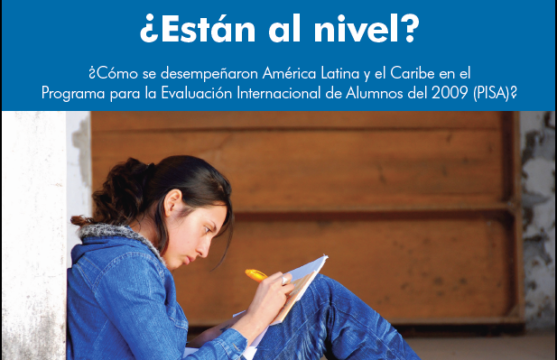
Teacher Evaluations Based on Student Performance
Wall Street Journal article discusses new teacher evaluation methods and how the results will be used for incentives.
This post is also available in: Spanish
The release of the 2012 PISA results in December presents a good opportunity to reflect on the state of education in Latin America.
As is well known,the eight Latin American countries that participated in PISA ranked in the bottom third in reading, mathematics, and science among the 65 countries that took the test. How can we interpret these results? What do they tell us about the challenges of education policy in our countries?
With these questions in mind I contacted a select group of experts in Latin America. Their comments and thoughts offer useful insights to kick-start a debate about the future of education systems in the region.
Not surprisingly, all of those contacted expressed concern for the relatively poor performance of Latin American countries. According to Guillermo Perry, former Minister of Finance of Colombia and an influential economist interested in education issues, the PISA resultsfor Colombia are “bad news because they show the quality of basic education remains very poor and unequal, and that most of the children do not acquire the basic skills needed to be productive workers in the world today. Even in private schools the percentage of students with high scores is very low”.
Sergio Bitar was Minister of Education in Chile under the Lagos administration. For him, the fact that Chile is first among all participating countries in Latin America and that its scores have improved does not lessen the concern about results. First, argues Bitar, “we are far from the best in the world and far from countries in Asia. Second, the percentage of youth in the lowest performance levels is very high, and only 1.6% of the students are in the top performance group. This shows that the entire system has low efficiency, even among students in private elite high schools. Third, inequality and socioeconomic segmentation are overwhelming and have a decisive influence on results.”
While concern over the low levels was common to all those consulted, the interpretation of patterns of change over time show some interesting differences across countries.
According to Santiago Cueto, researcher at GRADE in Peru and one of the main voices on learning assessments in the region, the PISA results for Peru show that we are not doing well, but we are doing better. Cueto points out that “the majority of Peruvian students performed at level 1 (or below) in math, science, and reading. PISA also shows Peru is a highly unequal country: the gap in performance between urban and rural students is striking and has not improved between 2001 and 2012. At the same time, Peru is the country that has most improved in reading from the first evaluation, in a context of considerable expansion in net coverage of 15-year-old students.”
Maria do Pilar Lacerda, former Secretary of basic education of Brazil, notes the same tension between levels and changes in a very graphic way. “If results for Brazil are regarded as a photo, they are not good, while if we look at them as a movie, there has been good progress.”
Despite the limitations of rankings, the strong contrast between the results of countries in Latin America and East Asia is difficult to ignore. Miguel Szekely, former undersecretary of education in Mexico, expresses frustration that “even when a country like Mexico makes progress, its relative position does not necessarily improve because others are moving faster. One is left feeling that we are running far behind.”
The strong contrast between the results of Asian and Latin American countries also signals the potential role of such basic factors as the settings in which educational practices take place in schools and at home. Gustavo Iaies, former secretary for basic education in Argentina and director of Fundación CEPP, highlights the fact that Argentina ranked near the top ofcountries in which students report that they have skipped class in the two weeks prior to the PISA exam and have a high perception of disorder in the classroom. In his opinion “these are indicators of a system that needs to rethink its basic conditions of operation and work on the reconstruction of an ‘educational order’ that replaces the current ‘mess’ in schools.”
At the same time, the comparison with East Asian countries brings up the importance of considering the role of individual and family effort in the pursuit of learning achievements. The order to which Iaies refers has many faces—order in school, at home, in the community—that interact in virtuous or vicious ways depending on the case.
The PISA results leave open the question of what can be done to improve the level of learning in Latin America. Leonardo Garnier, Costa Rica’s Minister of Education, argues that the most interesting aspect of PISA is not the horse race or the relative position different countries occupy, but the detailed information it provides on the specific strengths and weaknesses in the education systems. “This is what we are more interested in terms of informing decisions,” he stated.
Given the widely acknowledged importance of teachers in the learning process, it is not surprising that the experts consulted mentioned teacher policies as a priority area for reforms. Although many inputs determine the quality of education, Szekely argues, “clearly we must improve the capabilities of our teachers.”
According to Cueto, in contrast to the evaluative approach of PISA that focuses on problem solving, “teachers in Latin America concentrate their pedagogical work in the classroom on routine tasks, memorization and mechanical application of procedures. Many teachers have difficulties solving problems like those presented in the tests.” In his view, it “seems indispensable to attract stronger candidates to the teaching profession.”
Perry agrees and argues that, in the case of Colombia, “the main problem in terms of poor quality of education is, by far, that those studying to become teachers tend to be high-school graduates with weak performance in the entry exams and that furthermore, they do not receive good training or support.” In a recent study by Fundación Compartir, Perry and his colleagues proposed a series of measures to reverse this situation.
Similarly, Lacerda argues that it is necessary to make the teaching profession more attractive for ‘the best young people’ and that this may require better wages and career prospects.
Beyond the agreements or disagreements on the necessary policy actions, we must understand that the results of PISA (or similar tests) will not change dramatically overnight. Cueto reminds us that students who took the last PISA test were born at the end of the 1990s. Those who will take the next PISA test in 2015 are currently 13 years old and will have only one-and–a-half more years of instruction before the next assessment takes place. In the same vein, Minister Garnier points out that the reforms that have been implemented in Costa Rica should “be reflected in better results in tests three, six and nine years down the road.”
These comments indicate that, since policy changes take several years to be reflected in learning outcomes, it is urgent that they be implemented immediately and sustained over time. Instead of being discouraged by the long time it may take to improve performance, we must be inspired by the simple logic that sowing early will produce a better harvest later on.
PISA plays a critical role in enabling international comparisons of results and giving a complementary perspective of the most frequent measurements of learning at the national level. It reminds us that we can learn from the experience of others, without suggesting that we should mechanically copy policies and programs.
In addition, international tests such as PISA can have positive effects on national systems of evaluation. It can highlight needed changes in countries where such systems are not entirely credible and contain important technical flaws. And in those countries that already have solid and reliable evaluation systems, PISA offers an opportunity to use benchmarking as a tool for analysis to inform education policy.
Additional Analysis:
Wall Street Journal article discusses new teacher evaluation methods and how the results will be used for incentives.
PREAL publication analyzes how Latin American and Caribbean countries performed on PISA tests.
Results of PISA show China receives highest scores.
